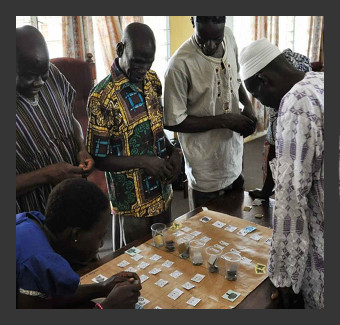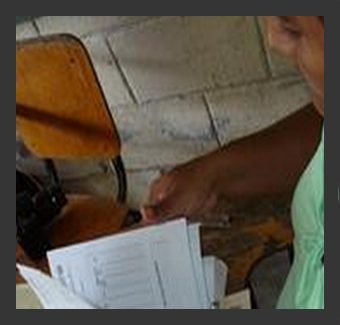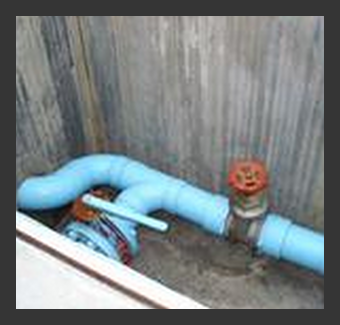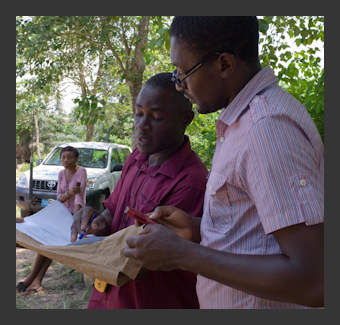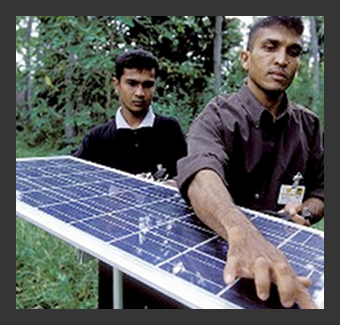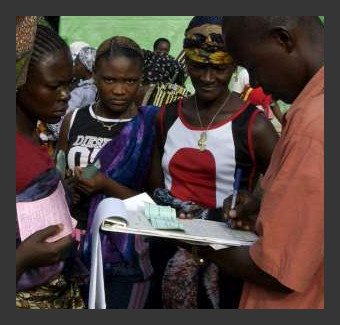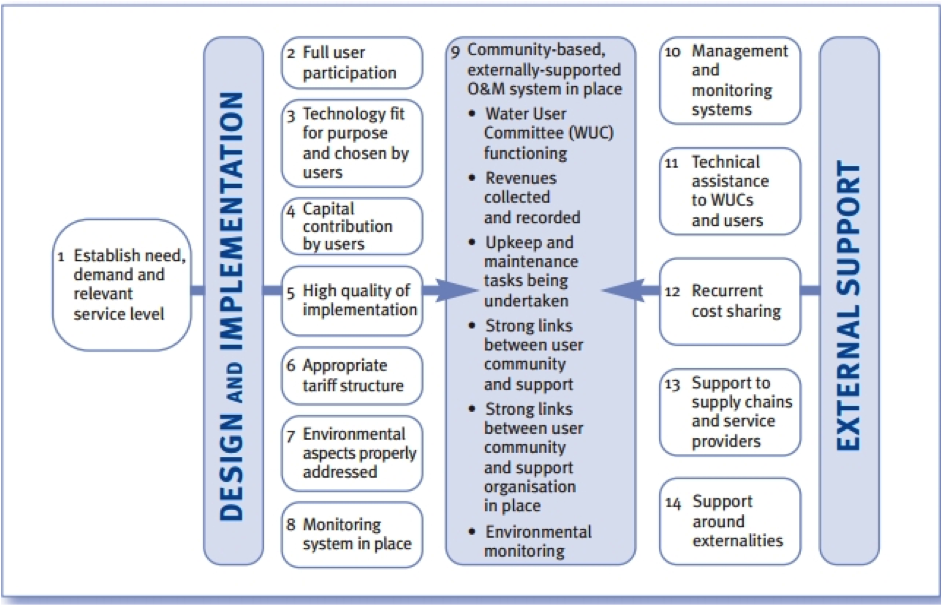Difference between revisions of "Sustainability Frameworks and Tools"
(Published from sandbox) |
(→Sustainability assessment tools) |
||
| (5 intermediate revisions by the same user not shown) | |||
| Line 8: | Line 8: | ||
To read more on Triple-S, visit the official [http://www.waterservicesthatlast.org/resources/building_blocks website]. | To read more on Triple-S, visit the official [http://www.waterservicesthatlast.org/resources/building_blocks website]. | ||
| − | <div style=" background-color: #efefef; text-align: center; -moz-border-radius: 2px; -webkit-border-radius: 2px; border: | + | <div style=" background-color: #efefef; text-align: center; -moz-border-radius: 2px; -webkit-border-radius: 2px; border: 5px solid #dedede; padding: 5px;" > |
| − | {|cellpadding=" | + | {|cellpadding="5" cellspacing="0" width="100%" |
|- | |- | ||
|colspan="5" style="background-color:#efefef;"| | |colspan="5" style="background-color:#efefef;"| | ||
|- | |- | ||
| − | + | |style="background:#efefef;"|[[Image:cap supp.jpg|center|100px|link=Capacity support - local government]] | |
| − | + | |style="background:#efefef;"|[[Image:professional0.png|center|100px|link=Professionalisation – Community Management]] | |
| − | + | |style="background:#efefef;"|[[Image:direct supp.png|center|100px|link=Direct support to service providers]] | |
| − | + | |style="background:#efefef;"|[[Image:harmonisation.png|center|100px|link=Harmonisation & Coordination]] | |
| − | + | |style="background:#efefef;"|[[Image:life-cycle costing.png|center|100px|link=Life-cycle costing]] | |
| − | |||
| − | |style="background:#efefef;"|[[Image:cap supp.jpg|center| | ||
| − | |style="background:#efefef;"|[[Image:professional0.png|center| | ||
| − | |style="background:#efefef;"|[[Image:direct supp.png|center| | ||
| − | |style="background:#efefef;"|[[Image:harmonisation.png|center| | ||
| − | |style="background:#efefef;"|[[Image:life-cycle costing.png|center| | ||
|- | |- | ||
|style="background:#efefef;"|<div class="center" style="width:auto; margin-left:auto; margin-right:auto;">[[Capacity support - local government|Capacity support - <br>local government]]</div> | |style="background:#efefef;"|<div class="center" style="width:auto; margin-left:auto; margin-right:auto;">[[Capacity support - local government|Capacity support - <br>local government]]</div> | ||
| Line 37: | Line 31: | ||
|colspan="5" style="background-color:#efefef;"| | |colspan="5" style="background-color:#efefef;"| | ||
|- | |- | ||
| − | + | |style="background:#efefef;"|[[Image:regulation sust.png|center|100px|link=Regulation]] | |
| − | + | |style="background:#efefef;"|[[Image:asset man.jpg|center|100px|link=Asset Management]] | |
| − | + | |style="background:#efefef;"|[[Image:alt serv small.png|center|100px|link=Alternative Service Provider Options]] | |
| − | + | |style="background:#efefef;"|[[Image:monitor small.jpg|center|100px|link=Monitoring]] | |
| − | + | |style="background:#efefef;"|[[Image:learn adapt small.jpg|center|100px|link=Learning & Adaptive Management]] | |
| − | |||
| − | |||
| − | |style="background:#efefef;"|[[Image:regulation sust.png|center| | ||
| − | |style="background:#efefef;"|[[Image:asset man.jpg|center| | ||
| − | |style="background:#efefef;"|[[Image:alt serv small.png|center| | ||
| − | |style="background:#efefef;"|[[Image:monitor small.jpg|center| | ||
| − | |style="background:#efefef;"|[[Image:learn adapt small.jpg|center| | ||
|- | |- | ||
| Line 61: | Line 48: | ||
<br> | <br> | ||
| + | |||
====FIETS sustainability approach==== | ====FIETS sustainability approach==== | ||
Developed by the Dutch WASH Alliance, this approach <ref>DWA, 2013. [http://www.washalliance.nl/wp-content/blogs.dir/2/files/sites/2/2013/04/fiets_sustainability_approach.pdf FIETS sustainability approach]. Haarlem, The Netherlands: Dutch WASH Alliance, c/o Simavi.</ref> identifies five key areas of sustainability: financial, institutional, environmental, technical and social. These elements have been chosen as the five pillars of this portal as a guide for all sustainable materials (other frameworks included) that are able to be categorized under these general FIETS topics. | Developed by the Dutch WASH Alliance, this approach <ref>DWA, 2013. [http://www.washalliance.nl/wp-content/blogs.dir/2/files/sites/2/2013/04/fiets_sustainability_approach.pdf FIETS sustainability approach]. Haarlem, The Netherlands: Dutch WASH Alliance, c/o Simavi.</ref> identifies five key areas of sustainability: financial, institutional, environmental, technical and social. These elements have been chosen as the five pillars of this portal as a guide for all sustainable materials (other frameworks included) that are able to be categorized under these general FIETS topics. | ||
| Line 74: | Line 62: | ||
A number of organisations are developing or financing tools that are focused on sustainability as part of broader efforts to monitor and evaluate the lasting impacts of programme investments. The Triple-S initiative identified five tools that have been pilot tested and produce an objective and quantifiable output that can be used to trigger improvements to programme design or take remedial actions. <ref>Boulenouar, J., Schweitzer, R. and Lockwood, H., 2013. [http://www.waterservicesthatlast.org/media/publications/mapping_sustainability_assessment_tools Mapping sustainability assessment tools to support sustainable water and sanitation service delivery. (Triple-S – Working Paper; 6)]. The Hague, The Netherlands: IRC International Water and Sanitation Centre.</ref> | A number of organisations are developing or financing tools that are focused on sustainability as part of broader efforts to monitor and evaluate the lasting impacts of programme investments. The Triple-S initiative identified five tools that have been pilot tested and produce an objective and quantifiable output that can be used to trigger improvements to programme design or take remedial actions. <ref>Boulenouar, J., Schweitzer, R. and Lockwood, H., 2013. [http://www.waterservicesthatlast.org/media/publications/mapping_sustainability_assessment_tools Mapping sustainability assessment tools to support sustainable water and sanitation service delivery. (Triple-S – Working Paper; 6)]. The Hague, The Netherlands: IRC International Water and Sanitation Centre.</ref> | ||
| − | AGUASAN - '''Sustainability Assessment Tool (SAT)''': Reviews existing interventions of on-going and completed programmes to support future WASH programme planning. The tool was pilot tested in Kosovo in 2010 and similarly in Haiti, Nepal, and Mali. Time duration: approximately two person-months for the detailed assessment, and one to two person-weeks for the “rough” assessment. Total costs have ranged between US$ 2,000-20,000 and have not exceeded the cost of conventional project evaluations for the organisations involved. [http://www.waterservicesthatlast.org/content/download/ | + | AGUASAN - '''Sustainability Assessment Tool (SAT)''': Reviews existing interventions of on-going and completed programmes to support future WASH programme planning. The tool was pilot tested in Kosovo in 2010 and similarly in Haiti, Nepal, and Mali. Time duration: approximately two person-months for the detailed assessment, and one to two person-weeks for the “rough” assessment. Total costs have ranged between US$ 2,000-20,000 and have not exceeded the cost of conventional project evaluations for the organisations involved. [http://www.waterservicesthatlast.org/content/download/3196/30320/version/2/file/SUSTAINABILITY+ASSESSMENT+TOOL.pdf More information]. |
DWA - '''Sustainability Monitoring Framework (SMF)''': Measures the extent to which each NGO contributes to sustainable WASH service delivery in their projects. Highlights the absence of issues which have been proven to result in low sustainability, and the presence of factors that promote sustainability. Pilot tested in Uganda and Ghana by a total of nine organisations, in collaboration with local authorities. The SMF was meant to be integrated in on-going programme monitoring initiatives. [http://www.washalliance.nl/2013/06/24/update-on-the-design-of-sustainability-monitoring-framework-progress/ Latest blog on the tool here]. | DWA - '''Sustainability Monitoring Framework (SMF)''': Measures the extent to which each NGO contributes to sustainable WASH service delivery in their projects. Highlights the absence of issues which have been proven to result in low sustainability, and the presence of factors that promote sustainability. Pilot tested in Uganda and Ghana by a total of nine organisations, in collaboration with local authorities. The SMF was meant to be integrated in on-going programme monitoring initiatives. [http://www.washalliance.nl/2013/06/24/update-on-the-design-of-sustainability-monitoring-framework-progress/ Latest blog on the tool here]. | ||
| Line 82: | Line 70: | ||
USAID/Rotary International - '''Sustainability Index Tool (SIT)''': Developed in 2012, during the first evaluation of the projects conducted under the USAID-Rotary International partnership in three countries: Ghana, the Philippines, and the Dominican Republic, and further refined in 2013. It is unique among the tools reviewed in this paper in that it includes a publicly available “product” which guides users through the assessment steps. The cost of applying the SIT is approximately US$ 50,000 per country. [http://www.washplus.org/rotary-usaid More information]. | USAID/Rotary International - '''Sustainability Index Tool (SIT)''': Developed in 2012, during the first evaluation of the projects conducted under the USAID-Rotary International partnership in three countries: Ghana, the Philippines, and the Dominican Republic, and further refined in 2013. It is unique among the tools reviewed in this paper in that it includes a publicly available “product” which guides users through the assessment steps. The cost of applying the SIT is approximately US$ 50,000 per country. [http://www.washplus.org/rotary-usaid More information]. | ||
| − | Water and Sanitation Africa - '''Tool for Planning, Predicting, and Evaluating Sustainability (ToPPES)''': A decision support system to analyse and predict service delivery sustainability for WSA project managers; although results would also be relevant for local government officials. Developed in Ghana from a data set created with the help of the national water ministry and the Community Water and Sanitation Agency (CWSA). Although ToPPES has been field tested and modified, it has not been fully applied. [http://www. | + | Water and Sanitation Africa - '''Tool for Planning, Predicting, and Evaluating Sustainability (ToPPES)''': A decision support system to analyse and predict service delivery sustainability for WSA project managers; although results would also be relevant for local government officials. Developed in Ghana from a data set created with the help of the national water ministry and the Community Water and Sanitation Agency (CWSA). Although ToPPES has been field tested and modified, it has not been fully applied. [http://www.ircwash.org/resources/tool-planning-predicting-and-evaluating-sustainability-toppes More information]. |
====WASH Sustainability Charter==== | ====WASH Sustainability Charter==== | ||
Latest revision as of 23:06, 19 May 2015
Which actions are needed to ensure that water and sanitation services are reliable and lasting, and how can sustainability be assessed? To answer these questions, WASH sustainability frameworks and assessment tools have been developed. In addition, some 100 sector organisations have endorsed a common set of sustainability principles called the WASH Sustainability Charter.
Frameworks
There are three well recognised sustainability frameworks for the WASH sector: the Triple-S building blocks, the FIETS sustainability approach and the WaterAid sustainability framework. While the Triple-S framework focuses exclusively on rural water services, the two others have a wider WASH focus. Another difference is that FIETS sustainability means (eventually) ending dependency on external (foreign) subsidies, while the two other frameworks still see a role for financial support from donors.
IRC Triple-S Building Blocks
The below icons lead to pages about the Triple-S Building Blocks as created by IRC. To read more on Triple-S, visit the official website.
FIETS sustainability approach
Developed by the Dutch WASH Alliance, this approach 1 identifies five key areas of sustainability: financial, institutional, environmental, technical and social. These elements have been chosen as the five pillars of this portal as a guide for all sustainable materials (other frameworks included) that are able to be categorized under these general FIETS topics.
WaterAid sustainability framework
For its country programmes, WaterAid developed a conceptual framework 2 for effective externally supported community-based management of water and sanitation services. The framework elements involve establishing demand, programme design and implementation, and external support to the community management system.
Sustainability assessment tools
A number of organisations are developing or financing tools that are focused on sustainability as part of broader efforts to monitor and evaluate the lasting impacts of programme investments. The Triple-S initiative identified five tools that have been pilot tested and produce an objective and quantifiable output that can be used to trigger improvements to programme design or take remedial actions. 3
AGUASAN - Sustainability Assessment Tool (SAT): Reviews existing interventions of on-going and completed programmes to support future WASH programme planning. The tool was pilot tested in Kosovo in 2010 and similarly in Haiti, Nepal, and Mali. Time duration: approximately two person-months for the detailed assessment, and one to two person-weeks for the “rough” assessment. Total costs have ranged between US$ 2,000-20,000 and have not exceeded the cost of conventional project evaluations for the organisations involved. More information.
DWA - Sustainability Monitoring Framework (SMF): Measures the extent to which each NGO contributes to sustainable WASH service delivery in their projects. Highlights the absence of issues which have been proven to result in low sustainability, and the presence of factors that promote sustainability. Pilot tested in Uganda and Ghana by a total of nine organisations, in collaboration with local authorities. The SMF was meant to be integrated in on-going programme monitoring initiatives. Latest blog on the tool here.
UNICEF Mozambique - Sustainability Check: Designed to be used by independent auditors to assess the sustainability of the country’s WASH facilities and make recommendations to programme managers. The average cost per assessment is US$ 65,000. Other UNICEF country programmes in Rwanda, Malawi and Zambia have developed similar checks greatly inspired by the Mozambique programme. More information.
USAID/Rotary International - Sustainability Index Tool (SIT): Developed in 2012, during the first evaluation of the projects conducted under the USAID-Rotary International partnership in three countries: Ghana, the Philippines, and the Dominican Republic, and further refined in 2013. It is unique among the tools reviewed in this paper in that it includes a publicly available “product” which guides users through the assessment steps. The cost of applying the SIT is approximately US$ 50,000 per country. More information.
Water and Sanitation Africa - Tool for Planning, Predicting, and Evaluating Sustainability (ToPPES): A decision support system to analyse and predict service delivery sustainability for WSA project managers; although results would also be relevant for local government officials. Developed in Ghana from a data set created with the help of the national water ministry and the Community Water and Sanitation Agency (CWSA). Although ToPPES has been field tested and modified, it has not been fully applied. More information.
WASH Sustainability Charter
In 2010, the first Sustainability Forum was held to discuss sustainable water, sanitation, and hygiene (WASH) services at scale. The following year, stakeholders came together to develop a common set of sustainability principles, which became the WASH Sustainability Charter. In January 2013, Coca-Cola became the 100th endorser of the Charter. In early 2012, individuals from a consortium of organizations (Aguaconsult, Global Water Challenge, IRC International Water and Sanitation Centre and WASH Advocates) created SustainableWASH.org, an online forum and resource for WASH sustainability.
Links
- IRC - Triple-S - waterservicesthatlast.org
- Dutch Water Alliance - washalliance.nl
- WaterAid - wateraid.org
- SustainableWASH.org - sustainablewash.org
References
- ↑ DWA, 2013. FIETS sustainability approach. Haarlem, The Netherlands: Dutch WASH Alliance, c/o Simavi.
- ↑ Carter, R., Casey, V. and Harvey, E., 2011. Sustainability framework. London, UK: WaterAid.
- ↑ Boulenouar, J., Schweitzer, R. and Lockwood, H., 2013. Mapping sustainability assessment tools to support sustainable water and sanitation service delivery. (Triple-S – Working Paper; 6). The Hague, The Netherlands: IRC International Water and Sanitation Centre.
